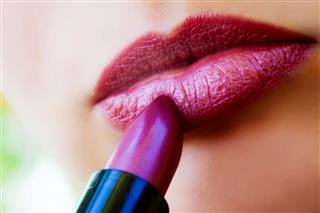
Although lipstick is the most commonly used cosmetic product in the world, and forms an essential component of a woman’s makeup, very few know what it is actually made of. Here we will take a look at the ingredients in lipstick.
A lipstick is considered as the most essential makeup item, something that no women can do without. Most women use it on a daily basis, but have you ever wondered about what it is made of? Ingredients in a lipstick may vary depending upon the brand, make and the color of the lipstick. However, all lipsticks contain some common ingredients, while some may also contain natural or organic ingredients.
The use of lipstick for make up, dates back to the times of the ancient Egyptians, who used henna or crushed insects like cochineal beetles to obtain shades of red lipstick. Solid lipstick was first invented by Abu al-Qasim al-Zahrawi, an Arab Andalusian cosmetologist. It was further popularized by Queen Elizabeth who made a fashion statement, with her blood red lips.
Ingredients in Lipstick
The raw material used for making lipsticks has to be approved by FDA, as lipstick is ingested unknowingly in some small amount. Although the proportion and the amount in which they are present may vary, lipsticks consist of the following ingredients.
Wax
The wax which is used in lipsticks is a combination of three types of wax, namely – beeswax, candelilla wax and carnauba wax. Candelilla wax is derived from the leaves of the Candelilla shrub. Carnauba wax is a type of plant wax, which is obtained from the leaves of Brazilian wax palm trees, and is more expensive than beeswax and candelilla wax. Therefore, lipsticks that contain more amount of carnauba wax tend to be expensive. Wax, as an ingredient enables lipstick to be molded into its characteristic shape.
Oil
It is the addition of oil that gives lipstick its shine and translucent effect. Different types of oils, like castor oil, vegetable oil, lanolin and mineral oil are used in lipsticks. Cocoa butter is also used along with these oils. Oil and wax are important constituents and they make about 60% of the total weight of the lipstick.
Pigments and Dyes
These are used in lipsticks to impart the desired color or shade to the lipstick. The dyes used in a lipstick include bismuth oxychloride, manganese violet, titanium dioxide, D&C Red No. 6, D&C Red No. 21, D&C Orange No. 17 and D&C Red No. 34. The pigments used are either obtained from plants, or are a mixture of various chemicals.
Alcohol and Fragrances
Alcohol is used as a solvent for the wax and oils used in making lipsticks. Fragrance is used for imparting a pleasant scent to the lipstick and to mask the smell of other ingredients.
Preservatives and Antioxidants
Preservatives and antioxidants are added to the lipstick to increase its shelf life and to prevent it from becoming stale or rancid.
Pearl essence
Contrary to its name, pearl essence is not made by crushing pearls. Pearl essence is made from the scales of shimmering fish like herring. Pearl essence is an ingredient in lipsticks that have shimmer and/or a pearl finish.
Apart from the ingredients mentioned above, lipsticks may also contain silica and mica. Emollients like vitamin E, shea butter and aloe vera are added to lipsticks to make them more moisturizing. Natural ingredients like jojoba oil, chamomile oil and organic pigments like turmeric extract and beetroot extract are also found in many lipsticks.
Harmful Lipstick Ingredients
Not all ingredients present in lipsticks is safe for use. Some lipsticks may consist of potentially harmful ingredients.
Lead
Some lipsticks contain trace amount of lead. Although FDA has not set any limit to the amount of lead that can be present in any particular cosmetic, lead can be very harmful if ingested. It can cause health hazards like infertility, anemia, cancer, learning disabilities and behavioral problems.
Coal Tar Derived Coloring
Pigments used for making red lipstick, especially Red #40, are derived from coal tar. Coal tar is a by-product of coke, which if ingested, can cause nausea, headaches and skin irritation.
Carmine
This is a natural coloring agent which is obtained by boiling pigmented cochineal scale insects. It is believed to cause skin irritations and allergies.
Lake Colors
Lake colors are oil dispersible colors, which are obtained from aluminum, barium, potassium and strontium. These colors might cause skin irritation.
Fragrances
Some artificial fragrances which are added to lipsticks can cause dry, chapped lips and dermatitis.
Lipsticks are available in a variety of finishes and colors. Before you purchase any lipstick, it is best to know what are the ingredients in it. This way, you can steer clear of any lipstick that contains harmful ingredients.
























